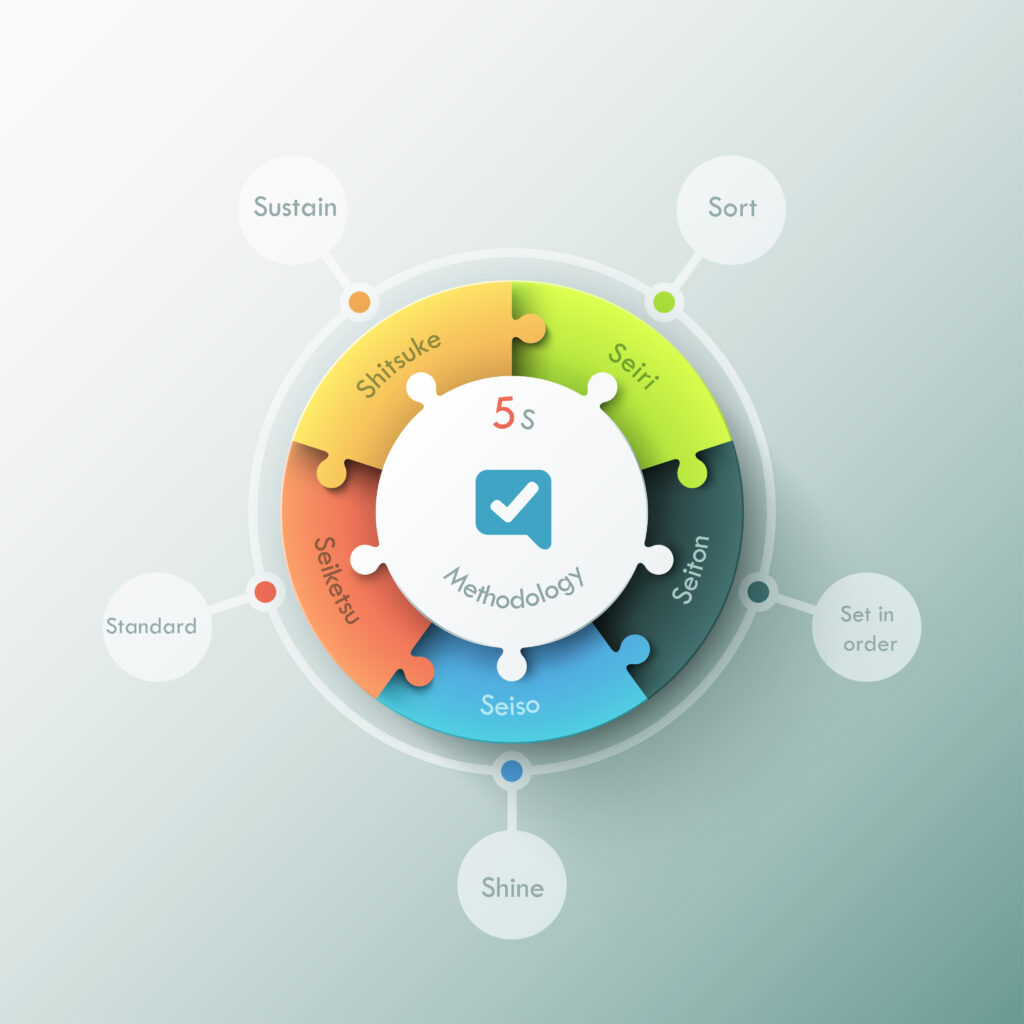
Love watching Marie Kondo on her Netflix show, “Tidying Up With Marie Kondo.”
If you have not had the pleasure of watching her and how she helps people declutter their homes encouraging them to get rid of the things they don’t need, then organise items that “sparks joy”.
Her simple concept is
Does this bring me joy?
She calls her method “KonMari” and based her book on this “The Life-Changing Magic of Tidying Up: The Japanese Art of Decluttering and Organizing.”
The central Kondo approach is KonMari and if something “Spark joy” in life and this is based around the business manufacturing method 5S which was begun by Toyota Motor Company and then transferred to be used in the home.

What is 5s?
5S is a Japanese system for organising business processes and workspaces to Increase productivity so work can be performed more efficiently, effectively, and safely. There are 5 steps each named after a different term beginning with the letter “S”
The 5 step 5S checklist process:
- Seiri – Sort
- Seiton – Set in order
- Seiso – Shine
- Seiketsu – Standardise
- Shitsuke – Sustain

Seiri – Sort
This is the decluttering stage or removing all unnecessary items that are not functionally important. Elimination of unnecessary tools, parts, and processes.
- Planning – Review designated areas
- Categorise – Items used on a daily basis, occasionally or obsolete
- Create Space – Dipose of obsolete items no longer used
- Create efficiency -Everything should have its place
The benefits of Seiri is when your items are sorted and in order, you save time not having to look for them
“Mottainai” means “Don’t waste”, or “Every little thing has a soul”
Seiton – Set in order
Creating a specific location for everything so it has its optimal positions. It is great to quickly find everything you need within easy reach without wasting time trying to locate it. Building a good workflow automation process to improve productivity.
- Create a 5S Map – Visual overview of the business processes
- Define Work Areas – Where work will be completed
- Labelling – signs, labels and colour-coded labels
- Ergonomic locations – Easily accessible
- Storage – Where items stored, how often used, easy to reach, and not having to move other items.
The most cost-effective principles to improve your business with a multitude of benefits for both team members and the overall business efficiency.
Seiso – Shine
Maintain cleanliness and keep everywhere tidy “to make everything shiny clean” make it a routine practice.
- Create time daily for cleaning process
- Supervise the daily activity – supervision check and monitoring
- Allocate Rolls – Make sure everyone knows what they must do
- Identify sources of dirt and formulate prevention plans
- Document the processes and layout guidelines and policies
Train your employees to understand the correct cleaning procedures and their responsibilities in the process and why maintaining good standards is important for health and safety.
Provide personal protective safety equipment like gloves and source for the right cleaning tools and products.
Seiketsu – Standardise
This is about process management. set out rules and guidelines to be followed by everyone. Standardise the best practice or standard operating procedures.
- Establish standard operating procedures – Enabling systematically repeating the first three steps
- Regular Evaluation – checklists and documents available
- Make a schedule
- Assign responsibility
- Conduct regular inspections and evaluations
Shitsuke – Sustain
Daily processes become routine “do without being told” discipline that is reinforced.
- Document – Standard Operating Procedure
- Create a Checklist – Reinforce steps and
- Communication – Explain clearly, add signage and make sure understood why happening
- Refinement – Ask for continuous feedback from employees to improve
- Evaluation – Analyse performance, results
A powerful tool for sustaining your processes is a checklist. Checklists provide physical evidence of the process management required for each task. Pointing out the steps that must be completed and can then be proof that the process has been completed to set guidelines so everyone has a clear understanding.
Documentation and checklists encourage consistency providing higher quality results because the work instructions are very clearly set out and step not missed causing mistakes and errors.
The 5S methodology is at the heart of what Six Sigma represents reducing waste in a business process.
Marie Kondo How to tell is something “Sparks Joy”
It’s really quite a simple task go through everything you own and hold it tight and decide whether it “sparks joy” in your life. Then discard items that don’t spark joy and then neatly store and organise whatever is left.
We have produced a Konmari Method Checklist to help you succeed in decluttering and only keeping things that “sparks joy”.
“Keep things because you love them – not just because”